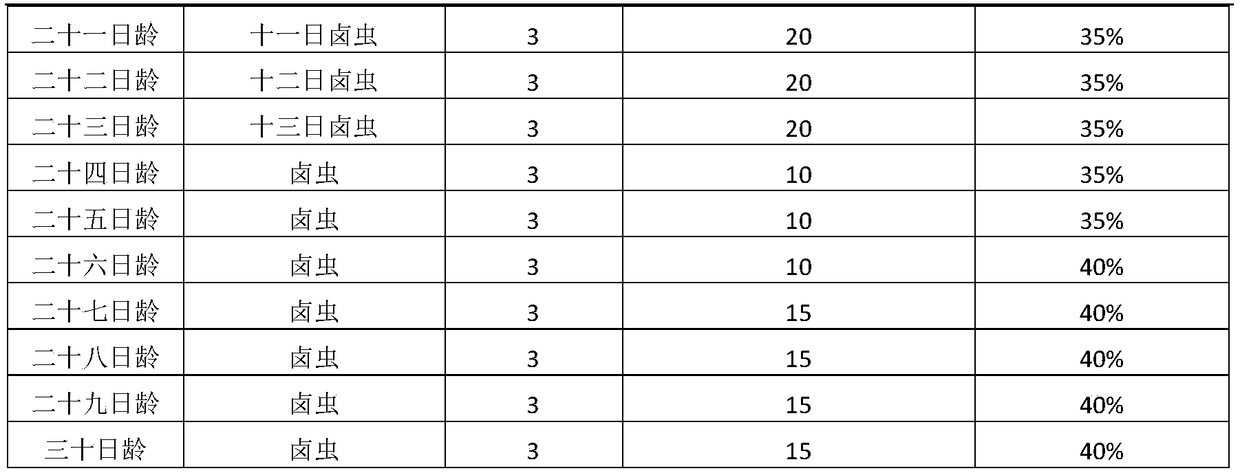Domestication method for increasing recapture rate of releasing proliferation hippocampus fingerlings in bohai sea
A technology of multiplying and releasing hippocampus, which is applied in climate change adaptation, animal feed, animal feed, etc., can solve the problems of declining hippocampus resources and hard to see traces, and achieve the effects of small changes in fatty acids, saving and strengthening, and low cost
- Summary
- Abstract
- Description
- Claims
- Application Information
AI Technical Summary
Problems solved by technology
Method used
Image
Examples
Embodiment 1
[0031] The invention relates to a domestication method for increasing the propagation, release and capture rate of seahorse seedlings in the Bohai Sea area, which includes a strengthening stage and a domestication stage.
[0032] Intensive phase (30 days)
[0033] This strengthening phase includes the following steps:
[0034] (1) Eliminate inferior seedlings. Inferior seedlings generally have whitish body color, incomplete body, underdeveloped, deformed head, and short snout. Especially the abdomen is the most obvious, with a yolk sac, lying on the bottom of the pool, with extremely poor swimming ability, unable to grow up, and unable to grow up after release, it is more common in the hippocampus born for the first time or prematurely born under extreme conditions.
[0035] The delivery density in the reinforcement phase is:
[0036] age of hippocampus
0~10
10~20
20~30
after 30
density
5 tails / L
3 tails / 2L
5 tails / 3L
2 tails / 5L ...
Embodiment 2
[0050] A method for domesticating seahorses, comprising a domestication stage, the various indicators of the domestication stage are as follows:
[0051] (1) Seed stocking density is:
[0052] age of hippocampus
0~10
10~20
20~30
after 30
density
5 tails / L
3 tails / 2L
5 tails / 3L
2 tails / 5L
[0053] (2) The rotifer larvae were fed within 24 hours after the seahorse seedlings were born.
[0054] (3) Feeding Artemia fished out from the breeding sea area. The feeding density is as follows:
[0055] domestication time / d
0~5
5~10
10~15
bait density
3% of the total weight of seedlings to be domesticated
2% of the total weight of seedlings to be domesticated
1% of the total weight of seedlings to be domesticated
[0056] (5) After strengthening, the hippocampus was reared in a flow acclimation pond with slow water inflow and outflow, and the bottom of the acclimation pond was silt.
[0057] (6...
Embodiment 3
[0061] A method for domesticating seahorses. The newly born seahorses are directly released after 30 days of breeding. The various indicators of the breeding process are as follows:
[0062] (1) The breeding temperature is 26-29°C, and the temperature fluctuation of the water body should not exceed ±4°C. If the temperature fluctuation is too large, the young hippocampus will be stressed, which will affect the feeding of the hippocampus, and eventually lead to the death of the hippocampus due to nutritional diseases.
[0063] (2) The salinity of the cultured water is 22-30 per thousand. Under this salinity, the young hippocampus grows obviously and is not prone to diseases.
[0064] (3) Breeding density:
[0065] age of hippocampus
[0066] The stocking density of juvenile seahorses is an important factor affecting the survival rate of seahorses. If the stocking density is too high, it is necessary to increase the amount of water exchange, which will cause the hippoc...
PUM
 Login to View More
Login to View More Abstract
Description
Claims
Application Information
 Login to View More
Login to View More - R&D
- Intellectual Property
- Life Sciences
- Materials
- Tech Scout
- Unparalleled Data Quality
- Higher Quality Content
- 60% Fewer Hallucinations
Browse by: Latest US Patents, China's latest patents, Technical Efficacy Thesaurus, Application Domain, Technology Topic, Popular Technical Reports.
© 2025 PatSnap. All rights reserved.Legal|Privacy policy|Modern Slavery Act Transparency Statement|Sitemap|About US| Contact US: help@patsnap.com



